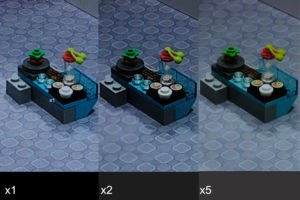-
The Oppo smartphone prototype with 5x optical zoom.Andrew Williams
-
The back of the Oppo 5x zoom prototype.Andrew Williams
-
The clever lens arrangement of the 5x zoom camera.Andrew Williams
-
As you can see, image quality at 2x (which is computed rather than native) is a bit iffy.Andrew Williams
-
Image EXIF data.Andrew Williams
-
1x zoom...Andrew Williams
-
5x zoom!Andrew Williams
-
Andrew Williams
-
Andrew Williams
-
Andrew Williams
-
Andrew Williams
The Chinese smartphone maker Oppo has showcased a phone at MWC 2017, which has a 5x camera zoom that makes the 2x zoom camera on the iPhone 7 Plus look positively unambitious.
Oppo's new tech is featuring in a working phone, albeit one that's unfinished. At one point during the demo, someone dropped one unit a mere six inches—and the back of the thing fell off completely. However, given Oppo’s track record with unusual camera designs, such as the rotating camera on the Oppo N1, don't yet write this off as a simple proof-of-concept that will never appear in a retail device.
The 5x zoom works in a similar fashion to the more modest one on the iPhone 7 Plus: there’s a normal camera sensor and lens, which sits alongside the 5x telephoto lens and sensor.

It works, and unlike the iPhone 7 Plus, both of the Oppo cameras have optical image stabilisation, making capturing sharp 5x shots a doddle—in fair light, anyway.
Oppo says its optical image stabilisation system is brand new, and claims an improvement of 40 percent over its existing phone OIS, and "precision" to 0.0025 of a degree. Both the prism and 5x zoom lens elements use stabilising motors, making it more complicated than most rivals.
Just using the phone at 5x makes the OIS tomfoolery obvious. Motion has that slightly odd smoothness to it even when looking at the preview image.
Tap the zoom button in the camera app and the Oppo prototype cycles between 1x, 2x, and 5x zoom levels, with a wheel that lets you choose any fine increment between 1x and 10x (which uses digital zoom). At 5x zoom, the Oppo is—no surprise here—radically better than the iPhone 7 Plus, both in terms of detail and clarity, while pixel level, colour, and dynamic range are also impressive.

At 2x zoom (pictured left), it's clear there’s still some work to be done on the algorithm that manages this. Check out our cropped sample comparison and you can see a strange blurry square over part of the image, which is even less defined than the same zone on the 1x shot.
All three zoom levels produce 13-megapixel pictures, suggesting that both cameras have 13-megapixel sensors at their core, although of course with software Oppo can make the images any size it likes. Producing 40-megapixel shots from a 13-megapixel camera is an Oppo mode of long-standing.
Android reports the aperture of both lenses as f/2.0, although as it also reports the focal length of all shots as being the same, it doesn’t necessarily follow that both lenses use this aperture.


Perhaps the most impressive part of the Oppo prototype is the way the camera setup takes up only about as much space as a standard dual-sensor camera array. As with the iPhone 7 Plus’s camera, the Oppo is perhaps worthy of being considered as a next-generation take on phone cameras. The zoom capability is greater, and there’s less sense that the secondary camera is somewhat diminished—in the iPhone's case because of the loss of image stabilisation in the 2x camera. When it's finalised, it could well prove to be the best gig photography and travel camera, at least for versatility, to date.
It's still nowhere near the Light L16, of course, which uses multiple cameras not only to offer digital zoom with optical-like quality, but to increase dynamic range and reduce noise. But a dual-camera array proves a significant limiting factor to the thinness of phones, meaning mainstream adoption of something like it by other manufacturers is probably quite far off.
When Oppo provides a pretty convincing 5x zoom with no moving parts and no extending lens, we’re perfectly happy to sacrifice a millimetre of thickness to let them get it right.
Listing image by Andrew Williams
reader comments
5